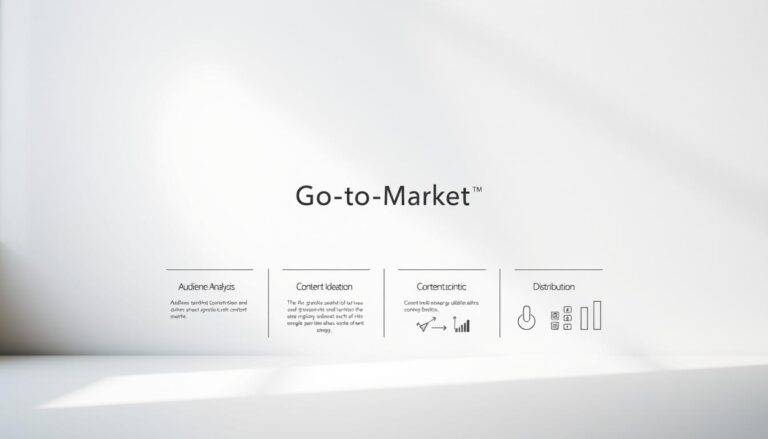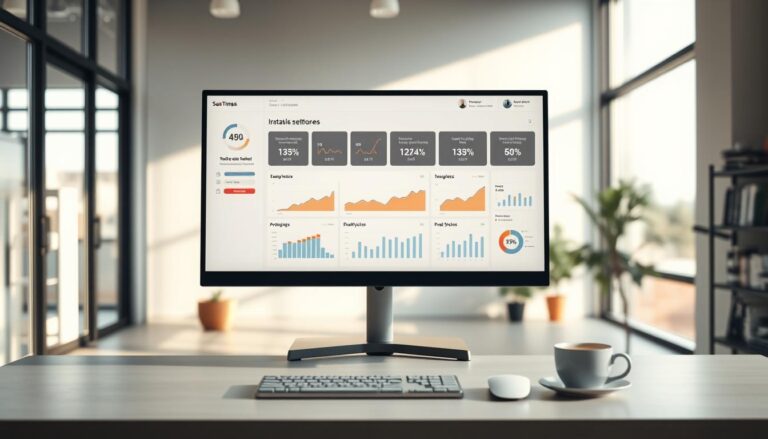In the current market, businesses are turning to AI to boost their growth plans. These AI strategies are changing how things are done by offering deep insights based on data. This allows companies to understand the market and what people want.
As things in the market change, businesses using new ways to grow are getting ahead. The power of AI is helping them change their processes for the better. This is key for entering new markets and staying strong.
Key Takeaways
- AI-driven market penetration tactics enhance growth strategies.
- Artificial intelligence strategies enable data-driven decision making.
- Understanding market dynamics and consumer trends is critical.
- Innovative market expansion techniques provide competitive advantage.
- AI tools streamline operational efficiencies for businesses.
- The adoption of AI is reshaping market entry approaches.
Understanding AI in Market Penetration Strategies
AI-driven tactics are key in helping companies tackle complex markets. By using advanced analytics and machine learning, businesses can improve their strategy to enter the market. It’s critical for companies desiring growth and a competitive edge to grasp these AI strategies.
Defining AI-Driven Tactics
AI tactics involve using artificial intelligence to enhance market strategies. Sophisticated algorithms are applied to analyze large sets of data, finding patterns that affect marketing. Hence, companies can create specific campaigns and plans that meet their customers’ needs efficiently.
Key Benefits of AI in Market Penetration
Integrating AI into market strategies brings many benefits. It leads to better customer segmentation for more personalized offers. Predictive analytics helps in understanding consumer behavior for timely decisions. With real-time intelligence, companies adapt quickly to market shifts, ensuring they stay competitive.
Trends Impacting AI Adoption
Many trends are boosting AI use in various industries. McKinsey’s research highlights the marketing sector’s huge gains from AI. The rise in AI tools investment shows a move towards valuing data-driven decisions and better customer connections. As AI-driven tactics become more popular, digital marketing is evolving, becoming crucial for today’s companies.
The Role of Data Analytics in Market Penetration
Data analytics is key in creating strong market entry plans. By studying different types of data, marketers can make smarter choices. This leads to more focused strategies and better ways to connect with people.
Types of Data for Effective Penetration
It’s vital to gather various data to grasp the market better. Important types of data include:
- Demographics: Information on age, gender, and income helps understand who the market is.
- Purchase History: Looking at what people have bought before shows what they like.
- Online Behavior: Studying how users interact with websites gives clues about what interests them.
Tools for Data Analysis in Marketing
Modern tools make analyzing data easier and help target the right customers. Important tools include:
| Tool | Functionality | Benefits |
|---|---|---|
| Google Analytics | Website traffic analysis | Shows how users behave on the site, giving insights into audience preferences |
| HubSpot | Marketing automation | Makes marketing simpler and gathers data for study |
| Tableau | Data visualization | Makes complex data easy to understand and attractive |
| CRM Systems (e.g., Salesforce) | Customer relationship management | Keeps customer data in one place, improving target marketing |
Interpreting Data for Strategic Decisions
Having top-notch data analysis tools is crucial. Marketers can then use advanced data analytics to spot trends and forecast what comes next. This leads to sharper strategies for reaching the right customers, helping to enter the market more effectively.

Personalization Through AI Technology
Using AI technology for personalized marketing lets companies connect with customers in a special way. Making interactions better not only makes users happy but also helps build brand love. By using AI to understand customer types, marketers can improve their methods for the best results.
Customizing Consumer Experiences
Leaders in business are seeing the value in making consumer experiences unique. They use AI-driven insights to learn what customers like and do. This information lets them make content that really speaks to different people, which draws them in and boosts sales. Making marketing personal creates a strong connection between people and brands.
AI and Customer Segmentation
Using AI to group customers is key for successful marketing. Brands use smart algorithms to sort customers by details like age, interests, and shopping habits. This makes sure messages get to the right people, making them more likely to buy. For businesses wanting to grow in smart ways, using AI this way is a must.
Case Studies: Successful Personalization
Many companies have used AI to make their services more personal. For example, Netflix and Amazon offer personalized picks to make their services better based on what users have liked before. Looking at these examples can teach businesses good tactics. Adding these personal touches not only keeps customers happy but also shows a brand really cares. For tips on using AI for personalization, check out this resource.
| Company | Strategy Used | Outcome |
|---|---|---|
| Netflix | Personalized viewing recommendations | Increased user engagement |
| Amazon | Customized product suggestions | Boosted sales and customer loyalty |
| Spotify | Tailored playlists and music suggestions | Enhanced user satisfaction |
Automating Marketing Campaigns with AI
The world of digital advertising is always changing. Marketing automation is a key way for businesses to do better and be more effective. By using AI, marketing becomes smoother. It helps with many tasks, making teams work better together. This part talks about the good stuff marketing automation brings. It also shares tips for using AI in campaigns and ways to see if campaigns are working well.
Benefits of Marketing Automation
When you use marketing automation, your organization gets many perks. These perks help you get better results. Let’s look at these benefits:
- Increased efficiency: Automation means less time on boring tasks. This lets marketing folks work on big picture stuff.
- Enhanced lead management: Systems help manage leads with messages that fit their brand experience.
- Data-driven decisions: Tools that use automation give valuable info about customers. This helps make better choices quickly.
Best Practices for AI-Driven Campaigns
For AI-driven campaigns to really hit the mark, follow these tips:
- Make sure automation lines up with your business goals. This keeps messages and strategies consistent.
- Keep your AI tools updated. This helps stay in tune with how consumer behavior changes.
- Use A/B testing to see what works best. Change your campaigns based on what the data tells you.
Evaluating Campaign Performance
To really get how your marketing is doing, you need a solid way to check on it. Think about these key points:
| Metric | Description | Importance |
|---|---|---|
| Conversion Rate | The percentage of users who take a desired action. | Shows if your campaign is getting people to do what you want. |
| Return on Investment (ROI) | What you earn back from every dollar spent on the campaign. | Tells you if your marketing efforts are paying off. |
| Engagement Rate | How much people interact with your content. | Reveals if your campaign is striking a chord with your audience. |

Competitive Analysis Using AI Tools
Competitive analysis is key for effective market entry strategies. It uses tools to find and study rivals’ tactics. This knowledge helps firms grasp the market better, leading to smarter choices.
Identifying Competitors and Their Strategies
Understanding the market requires knowing your competitors. It involves looking at their products, prices, and marketing. AI helps gather and understand this data, showing how firms stack up against rivals.
By seeing what others do well or poorly, companies can adjust their plans. This helps them compete better.
AI Tools for Market Insights
Many AI tools help with competitive analysis. They gather data from different sources for useful insights. Tools like Crayon and SimilarWeb track real-time competitor and market activities.
Using these tools, businesses can get ahead with the right data. They can change their strategies according to the latest market trends.
Implementing Insights for Strategic Advantage
After getting AI insights, companies need to use them wisely. This can lead to a big competitive edge. They might have to update marketing, improve products, or engage customers better.
By reacting to competitor moves, companies stay ahead. This reduces risks and boosts their place in the market.
Enhancing Customer Engagement Through AI
AI technology is now key in boosting how businesses talk to their customers. With chatbots technology and AI tools, companies can serve people better and build stronger bonds. This makes customer service faster and more personal.
Chatbots and Virtual Assistants
Chatbots and virtual assistants offer help any time, changing how customers get support. They’re always there to answer questions and handle tasks. By using chatbots technology, businesses make their customers happier with fast replies. Many businesses have seen better engagement and loyalty after adding chatbots.
AI-driven Content Recommendations
AI can figure out what customers like, making content suggestions very personal. By looking at what customers do, companies can make experiences that really speak to each person. This approach not only keeps customers interested but also builds lasting loyalty. Brands with AI for content suggestions see more customer activity and stronger relationships.
Fostering Customer Relationships
At the heart of engaging customers is creating real connections. Using AI to get what customers want and feel improves these ties. Data helps businesses understand emotional responses better. Making these efforts leads to better presence in the market. Leading companies focus on these personal touches, as shown in this informative link.
Measuring Success of AI-Driven Strategies
Evaluating AI-driven strategies is key for companies wanting to boost their market standing. They need to use Key Performance Indicators (KPIs) as standards for checking success. Choosing the right KPIs is important to see if campaigns are working and fitting with business goals.
Key Performance Indicators (KPIs)
KPIs help businesses see how well their AI marketing strategies are doing. There are several KPIs used often, like:
- Customer Acquisition Cost (CAC) – the cost to get a new customer.
- Return on Investment (ROI) – checks if campaigns are making money.
- Conversion Rate – how many people do what you want them to.
- Customer Lifetime Value (CLV) – predicts how much money a customer will bring over time.
- Engagement Metrics – looks at how users interact and behave.
Tools for Tracking Effectiveness
To check how well AI strategies work, there are tools and platforms that can help. Analytics software and dashboards are very important. They give up-to-date data and detailed reports. Some top choices are:
- Google Analytics – gives insights on website visitors and what they do.
- HubSpot – mixes CRM, analytics, and automation for easy monitoring.
- Tableau – lets you see data in detailed visual forms.
- Salesforce – puts marketing data and sales figures together.
Continuous Improvement and Adjustments
Improving constantly is a must. Companies should always look at data from AI metrics to make their strategies better. Learning from these metrics leads to smart changes that make campaigns more effective. Doing regular checks helps businesses stay ahead in a fast-changing market.
Future Trends in AI-Driven Market Penetration
Understanding AI’s future trends is vital for businesses aiming to improve their market presence. Technologies like machine learning and predictive analytics are changing how we analyze markets and target customers. This helps companies understand consumer patterns and adjust their marketing plans on time.
Emerging Technologies in Market Analysis
New AI tools, including natural language processing, are transforming market analysis. These tools offer detailed insights, allowing companies to make quick, informed decisions. By using these technologies, businesses can better meet customer needs and stay ahead of their competitors.
The Impact of AI on Consumer Behavior
AI is shaping the way consumers expect personalized experiences. This is due to AI-powered recommendations and ads. Companies need to adapt to this change to stay relevant in today’s fast-evolving market.
Preparing for Changes in the Market Landscape
Organizations must be flexible and quick to adapt to thrive. A focus on continuous learning and adaptation is key to dealing with market shifts. Proactively adjusting to AI advancements can lead to growth and successful market entry.
FAQ
What are AI-driven market penetration tactics?
AI-driven market penetration tactics use artificial intelligence and data analytics to help businesses enter new markets successfully. They focus on understanding how the market works and what the customer wants. Predictive analytics are used to develop strong strategies.
How does AI improve customer segmentation?
AI improves customer segmentation by analyzing data like who people are and what they buy. This helps companies identify and target specific groups more effectively. With this, businesses can reach out to customers in a way that truly fits their needs.
What are some examples of digital marketing solutions powered by AI?
Digital marketing solutions powered by AI include tools for automating lead handling, analyzing data with Google Analytics, and using chatbots for customer service. These AI solutions help make marketing more efficient and effective.
How does AI contribute to competitive intelligence?
AI helps gather and understand huge amounts of market data. This enables businesses to see what their competitors are doing and improve their own plans. It gives companies an advantage by making their market entry strategies smarter.
What role does data analysis play in market penetration strategies?
Data analysis is key for developing market penetration strategies. It turns complex data into useful insights. Using advanced analytics tools, businesses can make smart decisions that keep up with market changes.
Can you provide an example of successful personalization through AI?
A good example of AI-driven personalization is how e-commerce sites recommend products. By understanding what users like, these platforms can suggest items that people will likely want. This improves the shopping experience and helps build customer loyalty, aiding in market penetration.
What are the benefits of automating marketing campaigns with AI?
Automating marketing campaigns with AI lets marketers put more focus on big-picture strategies. Routine jobs, like sending emails or posting on social media, are done automatically. This approach leads to more effective campaigns and better results.
How can companies measure the success of their AI-driven strategies?
The success of AI strategies can be measured with Key Performance Indicators (KPIs) and analytics tools. These tools evaluate how well campaigns are doing. This way, companies can always be improving their strategies.
What future trends do you foresee in AI-driven market penetration?
Future trends in AI-driven market penetration might include new technologies for better market analysis and a stronger focus on personalization. Companies will need to adapt to these trends to meet the ever-changing expectations of consumers.



